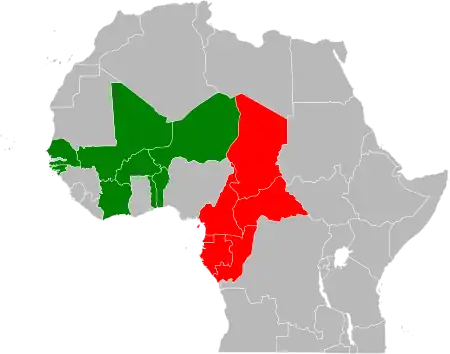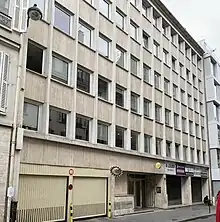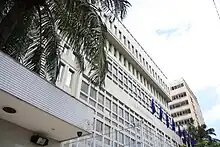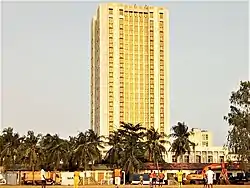Central Bank of West African States
The Central Bank of West African States (French: Banque Centrale des États de l'Afrique de l'Ouest, BCEAO) is a central bank serving the eight west African countries which share the common West African CFA franc currency and comprise the West African Economic and Monetary Union.
 | |
| Headquarters | Dakar, Senegal |
|---|---|
| Established | 1959 |
| Governor | Jean-Claude Brou |
| Central bank of | West African Economic and Monetary Union |
| Currency | West African CFA franc XOF (ISO 4217) |
| Reserves | 9 820 million USD[1] |
| Preceded by | Banque de l'Afrique Occidentale (1901-1955) Institut d’Emission de l’Afrique Occidentale Française et du Togo (1955-1959) |
| Website | www.bceao.int |

The BCEAO is active in developing financial inclusion policy and is a member of the Alliance for Financial Inclusion.[2]
History

In 1955, the French government transferred the note-issuance privilege for its West African colonies, hitherto held by the Banque de l'Afrique Occidentale, to a newly created entity based in Paris,[3] the Institut d’Emission de l’Afrique Occidentale Française et du Togo (lit. 'Note-Issuing Institute of French West Africa and Togo'). In 1959, the institution's name was changed to BCEAO.[4][5][6]
The treaty establishing the West African Monetary Union (French: Union Monétaire Ouest-Africaine, UMOA) was signed on 12 May 1962 and gave BCEAO the exclusive right to issue currency as the common central bank for the, then, seven member countries:[5][7][8] Ivory Coast, Dahomey (later renamed Benin), Haute-Volta (later renamed Burkina Faso), Mali, Mauritania, Niger, and Senegal. The statutes of the bank were subsequently approved in November 1962 and remained essentially unchanged until 1974, providing for dominant French influence over the BCEAO's governance.[3]
On June 30, 1962, Mali left the group and adopted the Malian franc as national currency. On December 17, 1963, Togo officially joined the UMOA. On May 30, 1973, Mauritania withdrew and adopted the ouguiya as national currency. On February 17, 1984, Mali re-joined the UMOA.[5] Guinea-Bissau joined the group in 1997.
In 1975, the BCEAO was led for the first time by an African Governor, Ivorian Abdoulaye Fadiga. It remained headquartered in Paris until mid-1978, when its head office was relocated to Dakar. The Dakar headquarters was formally inaugurated on 26 May 1979.[9]
Banking supervision

In 1989, BCEAO Governor Alassane Ouattara promoted the creation of a single banking supervisory authority for the entire West African Monetary Union, in a context of banking sector fragility in West Africa and widespread supervisory failure by the then-existing national banking commissions of the individual UMOA member states.[10]
The Banking Commission (French: Commission Bancaire) was established by an international convention signed by the participating governments in Ouagadougou on 24 April 1990, complemented by a bilateral agreement between the BCEAO and Ivory Coast on 16 October 1990 to establish the Commission in Abidjan with appropriate privileges and immunities.[10]
The Governor of the BCEAO acts as Chairman (French: Président) of the Banking Commission, whose operations are led by a Secretary-General (French: Secrétaire général) based in Abidjan.[10]
Member states
Buildings
The BCEAO has a main branch, known as agency, in the largest city of each of the member states, whose building typically dominates the local skyline.[11] In Dakar, the BCEAO's headquarters is in a high-rise building separate from the agency for Senegal. In addition, the BCEAO has branches in Parakou (Benin), Bobo-Dioulasso (Burkina Faso), Abengourou, Bouaké, Daloa, Korhogo, Man and San-Pédro (Côte d'Ivoire), Mopti and Sikasso (Mali), Maradi and Zinder (Niger), Kaolack and Ziguinchor (Senegal), and Kara (Togo).[12] In Paris, the BCEAO maintains a representative office in its former headquarters building at 29, rue du Colisée.
 BCEAO headquarters tower in Dakar (center)
BCEAO headquarters tower in Dakar (center) Benin Agency in Cotonou
Benin Agency in Cotonou Burkina Faso Agency in Ouagadougou
Burkina Faso Agency in Ouagadougou Guinea-Bissau Agency in Bissau
Guinea-Bissau Agency in Bissau Ivory Coast Agency in Abidjan
Ivory Coast Agency in Abidjan Mali Agency in Bamako (left)
Mali Agency in Bamako (left) Niger Agency in Niamey
Niger Agency in Niamey Branch building in Ziguinchor, Senegal
Branch building in Ziguinchor, Senegal
Leadership
Robert Julienne, a French national, was chief executive (French: directeur général) of the Institut d’émission, then of the BCEAO from 1955 to 1974,[9] after which the bank's head held the title of Governor.
Governor
- Abdoulaye Fadiga, 1975-1988[13]
- Alassane Ouattara, 1988-1990[9]
- Charles Konan Banny, 1990-2005[9]
- Justin Damo Baro, 2006-2008[9]
- Philippe-Henri Dakoury-Tabley, 2008-2011[9]
- Jean-Baptiste Compaoré, 2011[9]
- Tiémoko Meyliet Koné, 2011[9]-2022[14]
- Jean-Claude Brou, 2022-[14]
Secretary-General of the Banking Commission
- Djibril Sakho, October 1990 - October 1993[10]
- Marcel Kodjo, October 1993 - September 1998[10]
- Emmanuel Nana, September 1998 - February 2003[10]
- Mamadou Diop, February 2003 - January 2007[10]
- Eric Ekue, January 2007 - January 2009[10]
- Charles Luanga Ki-Zerbo, January 2009 - January 2012[10]
- Sanou Bolo, January 2012 - December 2014[10]
- Sena Elda Kpotsra, January 2015 - December 2019
- Antoine Traore, since December 2019
See also
References
- Weidner, Jan (2017). "The Organisation and Structure of Central Banks" (PDF). Katalog der Deutschen Nationalbibliothek.
- "AFI members". AFI Global. 2011-10-10. Archived from the original on 2012-02-20. Retrieved 2012-02-23.
- Rattan J. Bhatia (1985), "Chapter II: The Central Bank of West African States, 1962–74: Its Structure and Functions", The West African Monetary Union An Analytical Review, Washington DC: International Monetary Fund
- Mensah, A. (July 1979). "The Process of Monetary Decolonization in Africa" (PDF). Utafiti: Journal of the Faculty of Arts and Social Science, University of Dar Es Salaam. 4 (1): 48–49. Retrieved July 21, 2012.
- "Dates clés" (in French). Central Bank of West African States. Archived from the original on 2012-07-18. Retrieved July 21, 2012.
- "West African States CFA Franc Banknotes: First series of CFA banknotes issued by BCEAO 1959". Retrieved July 21, 2012.
- "Traité de l'Union Monétaire Ouest-Africaine" (in French). IZF. Archived from the original on February 22, 2013. Retrieved July 22, 2012. (Article 15)
- "Cadre Institutionnel" (in French). BCEAO. Archived from the original on July 18, 2012. Retrieved July 22, 2012.
- "Chronologie des évènements marquants de l'histoire de la BCEAO et de l'UMOA" (PDF). www.bceao.int. BCEAO.
- "Film institutionnel sur l'histoire de la commission bancaire de l'UMOA". Abidjan.netTV. 2015.
- René Boer (10 January 2014). "Two Banks Shaping the African Skyline". FA Failed Architecture.
- "Presentation of BCEAO". bceao.int.
- "Abdoulaye Fadiga". bceao.int.
- "Jean-Claude Kassi Brou Named Governor of Central Bank of West African States - SWFI". www.swfinstitute.org.
External links
- (in French and English) Official site: Banque Centrale des États de l'Afrique de l'Ouest